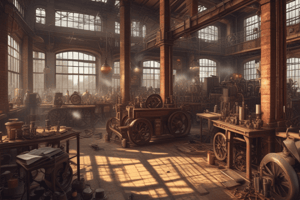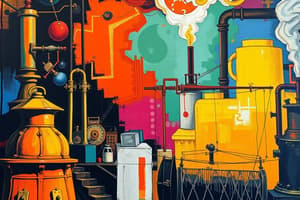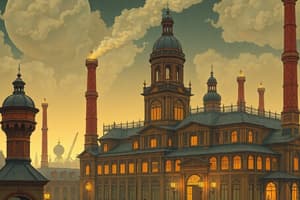Podcast
Questions and Answers
What did Hargreaves invent?
What did Hargreaves invent?
Spinning Jenny
What did Arkwright invent?
What did Arkwright invent?
Water frame
Who invented the steam engine?
Who invented the steam engine?
Newcomen and Savery
What improvement did Watt make to the steam engine?
What improvement did Watt make to the steam engine?
What did Cort invent?
What did Cort invent?
What did Haussman do?
What did Haussman do?
What did Balzac write and what style did he use?
What did Balzac write and what style did he use?
What contribution did Lister make to medicine?
What contribution did Lister make to medicine?
What topic did Chadwick focus on?
What topic did Chadwick focus on?
What did Pasteur discover?
What did Pasteur discover?
Why was Elizabeth Strut essential to her family's business?
Why was Elizabeth Strut essential to her family's business?
What was Thomas Malthus's main argument in his book, "Essay on the Principle of Population"?
What was Thomas Malthus's main argument in his book, "Essay on the Principle of Population"?
What was the difference between the U.K.'s industrialization and Europe's?
What was the difference between the U.K.'s industrialization and Europe's?
What were the weaknesses of the continental countries' industrialization?
What were the weaknesses of the continental countries' industrialization?
What was the Amalgamated Society of Engineers?
What was the Amalgamated Society of Engineers?
Did factories prefer to hire entire families to work?
Did factories prefer to hire entire families to work?
What were the first products that Britain's first factories produced?
What were the first products that Britain's first factories produced?
What were some of the negative aspects of factory work?
What were some of the negative aspects of factory work?
What were some of the factors that contributed to Britain's rise in industrialization? (Select all that apply)
What were some of the factors that contributed to Britain's rise in industrialization? (Select all that apply)
What was the first use of the steam engine?
What was the first use of the steam engine?
What did James Watt do to improve the steam engine?
What did James Watt do to improve the steam engine?
What were the two cities connected by the world's first railroad?
What were the two cities connected by the world's first railroad?
How did the reduced cost of freight impact industrialization?
How did the reduced cost of freight impact industrialization?
Who built Europe's railroads?
Who built Europe's railroads?
What was the Crystal Palace, and what did it hold?
What was the Crystal Palace, and what did it hold?
What did William Cockerill do?
What did William Cockerill do?
What did Fritz Harcourt do? (Select all that apply)
What did Fritz Harcourt do? (Select all that apply)
What did Frederick List do?
What did Frederick List do?
Why were the continental banks good and bad?
Why were the continental banks good and bad?
How did the Industrial Revolution impact worker's diets?
How did the Industrial Revolution impact worker's diets?
What did Engels write about?
What did Engels write about?
What was the biggest change from the cottage industry to factory work?
What was the biggest change from the cottage industry to factory work?
In the first half of the nineteenth century, labor legislation primarily focused on what?
In the first half of the nineteenth century, labor legislation primarily focused on what?
What did Robert Owen do? (Select all that apply)
What did Robert Owen do? (Select all that apply)
What were subcontractors, and what role did they play in industrialization?
What were subcontractors, and what role did they play in industrialization?
Why did the pay scale between men and women become more distinct during the Industrial Revolution?
Why did the pay scale between men and women become more distinct during the Industrial Revolution?
What did the Factory Act of 1833 do?
What did the Factory Act of 1833 do?
What did the Mine Act of 1842 do?
What did the Mine Act of 1842 do?
What did the Combination Act of 1799 do?
What did the Combination Act of 1799 do?
What was the main goal of the Chartists?
What was the main goal of the Chartists?
Who primarily paid for the railroads on the Continent?
Who primarily paid for the railroads on the Continent?
Who were mostly hired to work in factories?
Who were mostly hired to work in factories?
What was the per-capita level of industry? (from a chart)
What was the per-capita level of industry? (from a chart)
Why was the capitalist class so important to industrialization?
Why was the capitalist class so important to industrialization?
What were some of the benefits of industrialization for Britain? (Select all that apply)
What were some of the benefits of industrialization for Britain? (Select all that apply)
What were the essential components that countries needed in place for the Industrial Revolution? (Select all that apply)
What were the essential components that countries needed in place for the Industrial Revolution? (Select all that apply)
After 1815, how did the Industrial Revolution affect continental Europe's wheat production? (Select all that apply)
After 1815, how did the Industrial Revolution affect continental Europe's wheat production? (Select all that apply)
What did the Luddites do?
What did the Luddites do?
What products were France and Belgium known for?
What products were France and Belgium known for?
What were Customs Unions?
What were Customs Unions?
What did the growth of prostitution reflect during the Industrial Revolution?
What did the growth of prostitution reflect during the Industrial Revolution?
Did married, middle-class women's rights increase or decrease in the first half of the 19th century?
Did married, middle-class women's rights increase or decrease in the first half of the 19th century?
Who did Engels accuse of exploitation in his book?
Who did Engels accuse of exploitation in his book?
What factors contributed to the spread of industrialization from Britain to Continental Europe? (Select all that apply)
What factors contributed to the spread of industrialization from Britain to Continental Europe? (Select all that apply)
How did the invention of the spinning jenny initially impact the labor force by gender?
How did the invention of the spinning jenny initially impact the labor force by gender?
Why was the water frame significant despite its production of thick thread?
Why was the water frame significant despite its production of thick thread?
Besides his engineering work, what is one other contribution by Haussmann?
Besides his engineering work, what is one other contribution by Haussmann?
How did the application of coke impact the iron industry?
How did the application of coke impact the iron industry?
What was a notable business practice that Elizabeth Strutt demonstrated beyond textile production?
What was a notable business practice that Elizabeth Strutt demonstrated beyond textile production?
How did the Napoleonic Wars affect industrialization in continental Europe?
How did the Napoleonic Wars affect industrialization in continental Europe?
What was negative about factories during early industrialization?
What was negative about factories during early industrialization?
What was a key obstacle to the spread of industrialization across continental Europe?
What was a key obstacle to the spread of industrialization across continental Europe?
What shift in labor practices led to the rise of subcontractors during the Industrial Revolution?
What shift in labor practices led to the rise of subcontractors during the Industrial Revolution?
Besides limiting child labor and working hours, what other significant impact did the Factory Act of 1833 have on factory regulations?
Besides limiting child labor and working hours, what other significant impact did the Factory Act of 1833 have on factory regulations?
Beyond just banning unions, what were the Combination Acts of 1799 designed to suppress?
Beyond just banning unions, what were the Combination Acts of 1799 designed to suppress?
What specific political reforms did the Chartists advocate for, beyond broader goals of societal change?
What specific political reforms did the Chartists advocate for, beyond broader goals of societal change?
In what ways did the industrial advancements in France and Belgium differ from Great Britain, besides the specific products they were known for?
In what ways did the industrial advancements in France and Belgium differ from Great Britain, besides the specific products they were known for?
Besides Britain, which European country was the first to meaningfully adapt new farming methods?
Besides Britain, which European country was the first to meaningfully adapt new farming methods?
What effect did Britain's bountiful crops and cheap prices have on families' spending habits during the Industrial Revolution?
What effect did Britain's bountiful crops and cheap prices have on families' spending habits during the Industrial Revolution?
How did Britain's government policy encourage industrialization?
How did Britain's government policy encourage industrialization?
What two factors contributed to a large market for British goods, according to the provided text?
What two factors contributed to a large market for British goods, according to the provided text?
How did the expansion of railroad networks impact the cost of goods during the Industrial Revolution?
How did the expansion of railroad networks impact the cost of goods during the Industrial Revolution?
How did the reduced cost of shipping goods contribute to larger factories and improved machinery?
How did the reduced cost of shipping goods contribute to larger factories and improved machinery?
What was the effect of railroad expansion on the traditional artisans and cottage workers?
What was the effect of railroad expansion on the traditional artisans and cottage workers?
What was the purpose of the Great Exhibition of 1851 held in the Crystal Palace?
What was the purpose of the Great Exhibition of 1851 held in the Crystal Palace?
Flashcards
Industrial Revolution
Industrial Revolution
A period of major industrialization in the 18th and 19th centuries.
Spinning Jenny
Spinning Jenny
Invented by James Hargreaves, it allowed multiple spools of thread to be spun at once.
Power Loom
Power Loom
Invented by Cartwright, it mechanized the weaving process, boosting efficiency.
Steam Engine
Steam Engine
Signup and view all the flashcards
Malthusian Theory
Malthusian Theory
Signup and view all the flashcards
Working Conditions
Working Conditions
Signup and view all the flashcards
First Factories
First Factories
Signup and view all the flashcards
Crystal Palace
Crystal Palace
Signup and view all the flashcards
Liverpool and Manchester Railroad
Liverpool and Manchester Railroad
Signup and view all the flashcards
Engels' Accusation
Engels' Accusation
Signup and view all the flashcards
Luddites
Luddites
Signup and view all the flashcards
Factory Act of 1833
Factory Act of 1833
Signup and view all the flashcards
Mine Act of 1842
Mine Act of 1842
Signup and view all the flashcards
Combination Act of 1799
Combination Act of 1799
Signup and view all the flashcards
Chartists
Chartists
Signup and view all the flashcards
Role of Women
Role of Women
Signup and view all the flashcards
Transportation Impact
Transportation Impact
Signup and view all the flashcards
Continental Industrialization Weakness
Continental Industrialization Weakness
Signup and view all the flashcards
Steam Engine Advancement
Steam Engine Advancement
Signup and view all the flashcards
Energy Requirements
Energy Requirements
Signup and view all the flashcards
Subcontractors
Subcontractors
Signup and view all the flashcards
Friedrich List
Friedrich List
Signup and view all the flashcards
Cottage Industry to Factory Work
Cottage Industry to Factory Work
Signup and view all the flashcards
Freight Costs Reduction
Freight Costs Reduction
Signup and view all the flashcards
Puddling Furnace
Puddling Furnace
Signup and view all the flashcards
British Colonial Empire
British Colonial Empire
Signup and view all the flashcards
Steam Engine Purpose
Steam Engine Purpose
Signup and view all the flashcards
James Watt's Contribution
James Watt's Contribution
Signup and view all the flashcards
First Railroad
First Railroad
Signup and view all the flashcards
Labor Force Transformation
Labor Force Transformation
Signup and view all the flashcards
Crystal Palace Exhibition
Crystal Palace Exhibition
Signup and view all the flashcards
William Cockerill
William Cockerill
Signup and view all the flashcards
Hargreaves' Invention
Hargreaves' Invention
Signup and view all the flashcards
Thomas Malthus
Thomas Malthus
Signup and view all the flashcards
Chadwick's Observations
Chadwick's Observations
Signup and view all the flashcards
Elizabeth Strutt
Elizabeth Strutt
Signup and view all the flashcards
Amalgamated Society of Engineers
Amalgamated Society of Engineers
Signup and view all the flashcards
Factory Work Families
Factory Work Families
Signup and view all the flashcards
Working Conditions in Factories
Working Conditions in Factories
Signup and view all the flashcards




